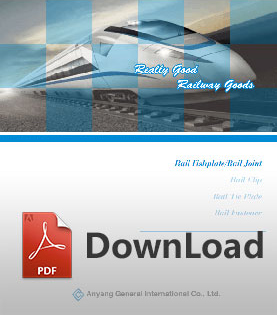Comparison Of Railway Sleepers

The railway sleeper is one of the important foundations of the railway track. It is used to carry the weight of the train and pass it to the rail bed. This paper classifies the railway sleepers according to the materials, describes their performance characteristics, and focuses on the research and analysis of the use of several composite sleepers that have appeared in recent years.
The wooden sleeper is the first type of railway sleeper used in the railway, especially the pine sleeper, which is used more often, and later concrete sleepers appeared. However, on the railway steel bridge, due to the poor elasticity of the concrete sleeper, it cannot be used, and only the wooden sleeper can be used. Although the wooden sleeper has good elasticity, it has a short service life and frequent replacement. Therefore, it is necessary to study a new type of sleeper - composite sleeper for the steel bridge. In recent years, several composite sleepers have been researched and produced using new technologies and processes at home and abroad. These composite sleepers include FFU synthetic sleepers, polyurethane composite elastic sleepers, integral coated recycled rubber composite sleepers, composite rubber elastic sleepers and so on. This paper compares the performance of wooden sleepers, concrete sleepers and several composite sleepers.
Performance comparison
Wooden sleeper
The performance advantages of wooden sleepers include light weight, good elasticity, good insulation performance, simple production, convenient transportation and maintenance, etc. But there are disadvantages of short life, frequent replacement, large consumption of wood, and A large number of human and financial resources and material resources consumption per replacement. Orbital geometry is also not easy to maintain and other shortcomings.
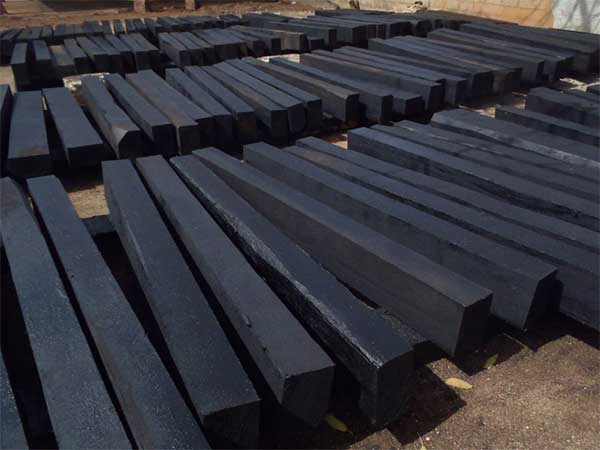
Concrete sleeper
The performance advantages of concrete sleepers include the less affect by climate or decay, warranted size, uniform elasticity, good stability, long service life, less maintenance and repair times, low cost. In addition, higher track bed resistance of concrete sleeper is very beneficial to improve the lateral stability of the seamless line; however, its disadvantages include heavy weight, poor elasticity and insulation performance. A buffer insulation layer is required at the bottom part of the rail, and the rail joint parts are complicated. It is more difficult to replace.
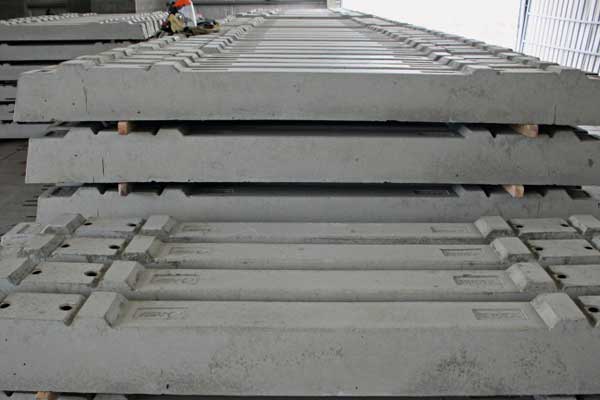
FFU synthetic sleeper
FFU synthetic sleeper, referred to as long glass fiber reinforced foam polyurethane. A long glass fiber and a hard polyurethane resin are used as a main component, and a molded plate compress and bond to frm the synthetic sleepers. Compared with other materials, this material has high corrosion resistance, fatigue resistance, electrical insulation resistance, long service life, up to 50 years, low replacement frequency, and can reduce cycle cost. And the FFU synthetic sleeper is light in weight, its weight is only 1/3 of the concrete sleeper, and its waste can be recycled after being crushed and pressurized to make a new recycling product.
Polyurethane composite elastic sleeper
Polyurethane composite elastic sleeper, the structure is divided into inner core and peripheral layer. The inner core is made of strong - concrete core such as full-grain FRP, and the FRP steel bar made of high-performance fiber such as glass fiber, it has the advantages of light weight, high strength, fatigue resistance, corrosion resistance, etc. The pre-stressed concrete core is characterized by high strength, high ductility, good corrosion resistance, good insulation and long service life. The peripheral layer is made of a material such as a glass long fiber reinforced polyurethane resin foam, and the long glass fibers are uniformly distributed in a monofilament shape, and the foam maintains completely independent bubbles. The peripheral layer has the characteristics of high strength, good elasticity, insulation and corrosion resistance. The composite sleeper has good shock absorption and noise reduction performance, corrosion resistance, good insulation and service life of more than 50 years.
Coated reclaimed-rubber composite sleeper
The coated reclaimed rubber composite sleeper, the structure is also composed of the inner core and the outer layer, and then integrally molded by special equipment.
The inner core structure of composite sleeper is divided into a w-groove inner core structure and a wooden core type structure. The w-groove inner core structure is composed of a w-shaped groove, a fixed nail block, and concrete. The inner core of the w-shaped groove is pressed from the steel plate to take the leading load. The fixing block is made of composite material, it is installed on the bearing part to facilitate the installation of the fastener system and increase the elasticity of the sleeper. Fill the concrete material in the spare part of the groove to enhance the load bearing capacity and increase the stability.
The wooden core structure is divided into old wooden sleeper repair type, new wooden sleeper type, and wood powder composite type.
- The old wooden sleeper repair type repair the old wooden sleeper, and the old wooden sleeper is covered by special equipment to make it renewed, thereby prolonging its service life;
- The new wooden sleeper type process wood into a certain inner core according to needs, and do the outer layer coating treatment directly, try to avoid the shorts of traditional wooden sleeper, such as putrescibility and crack, prolong the service life, and the wood is no longer required to be treated with antiseptic treatment, thereby eliminating the environmental pollution of the preservative and the harm to the human body;
- The wood powder composite type is obtained by blending wood waste, wood powder and other polymer composite materials to form an inner core, and then coating the wood to achieve the purpose of saving wood. The peripheral layer is made of recycled polymer rubber composite materials by special process such as waste tires and waste plastics. After the inner core of the sleeper is fed into the special equipment by the tractor, the composite material is continuously and automatically coated on the inner core surface, and the sleeper coating layer is formed at one time without joints in the middle, greatly improving the reliability and the service life, reducing the production cost and maintenance costs.
Recycled rubber-plastic composite material has the high elasticity of rubber and the high strength of plastic, so that its outer layer has the advantages of good elasticity and high compressive strength, so as to cope with the dynamic effect of train wheel and rail in railway transportation; at the same time, it can absorb noise. reduce vibration and make the track structure more stable.
Composite rubber railway elastic sleeper
How are composite rubber railway elastic sleepers made? combines waste plastics, waste paint and recycled rubber powder made of waste tires to plasticize and blend, and then extrude a new material-recycled rubber-plastic composite material. The property of material is close to wood, but the strength, elasticity, corrosion resistance and processing performance are more than wood. Compared with the existing wooden sleeper and concrete sleeper, the composite sleeper has good insulation, shock absorption and noise reduction performance, low installation and maintenance cost, long service life and high comprehensive cost performance.
Analysis of the cost and application
- The raw materials of wooden sleepers are mainly pine and other materials with good quality. The price of a wooden sleeper is about 230-270 yuan, but the wooden sleeper has a short service life and frequent replacement. Due to the lack of wood resource and large consumption, the wide application of wooden sleepers has become a thing of the past.
- The main component of concrete sleepers is cement. The production cost is low. The price of a concrete sleeper is about 75-90 yuan. There are many material resource of concrete sleeper. With relatively rapid development and application, at present, China's railways basically adopt concrete sleepers.
- FFU synthetic sleepers are widely used in Japan, but the cost is high. The price of a FFU synthetic sleeper is calculated to be more than 2,500 yuan. The composite sleeper is experimentally researched in China. It has a production line in Shanghai, but it is not used on Chinese railways. Just like FFU synthetic sleeper, the cost of Polyurethane composite elastic is high, and they are not yet used on the Chinese railway. The whole coated reclaimed rubber composite sleeper has many production processes and high cost. It has been developed and produced in Qingdao, China, and has been exported to the United States, India, Chile and other countries, but has not been used on Chinese railways; Composite rubber railway elastic sleeper has low cost, but the process is more complex, widely used in the US first-class railway and short-distance railway. The products have been used in railway construction projects in Australia, India, Thailand and other countries, but have not been used on Chinese railways.
The sleeper is an important part of the railway. In China, the railway sleeper is mainly made up of concrete sleepers, and the wooden sleepers are used on the steel bridge. Due to the lack of wood resources and the short service life of the wooden sleepers, it is necessary to study the composite sleepers on the steel bridges, compared with the wooden sleepers. Concrete sleepers and composite sleepers meet the requirements of railway construction development in terms of performance and recyclability. They will bring both huge economic profits and far-reaching environmental benefits.
With the development of science and technology, adopt new materials, new processes and new technology, the research and application of composite sleepers will become more and more extensive, and will certainly become the development direction of railway special section sleepers.
You may also like:
- How much do you know about railway sleepers?
- A Guide of Concrete sleeper
- What Is A Timber Sleeper?
- Where to Buy Railway Sleepers?
- Railway sleeper materials overview: wood, steel, concrete, plastic
- How to build a raised bed with railway sleepers?
- How to fasten railroad screw spikes to railway sleepers
- Rail sleeper
- Rail Fasteners
- rail fastening system
- rail clip
- railroad spike
- Track bolt
- rail shoulders
- rail anchor
- rail clamp
- tie plate
- Rail Pad
- rail insulator
- rail plastic dowel
- other rail fasteners
- Railway Switch
- SKL series rail fastening system
- Chinese standard rail fastening system
- screw spikes
- Crane rail fastening system
- K type rail clip for Africa
- Hey-Back Rail Fastening
- rail fasteners for Mexican market
- Ss25 screw spike
- Ss35 rail sleeper screw spike
- Ss8 screw spike
- coach screw
- Crane Rail Clip
- Rail Joints (Fishplate)
- Steel Rail
- Railway Sleeper
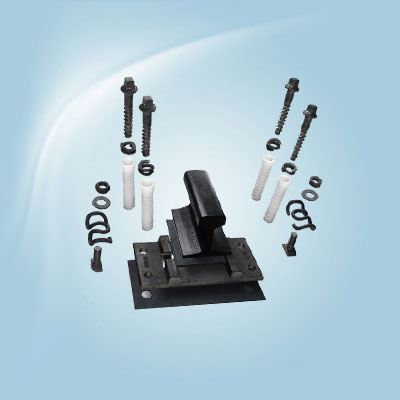 rail clip
rail clip
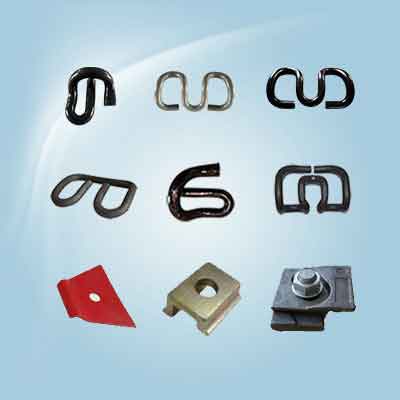 rail joints
rail joints

 Español
Español English
English
